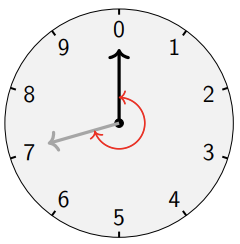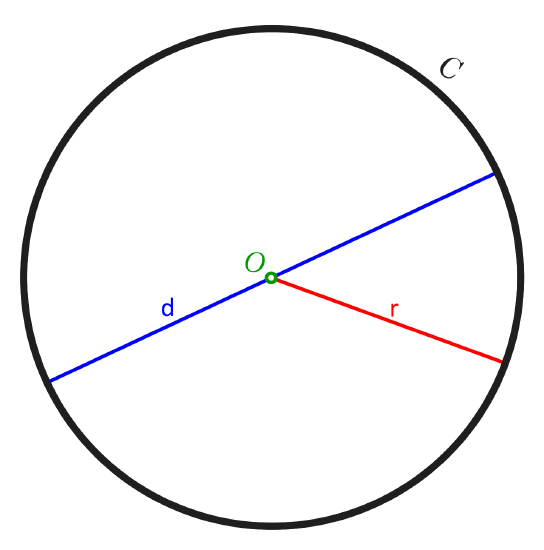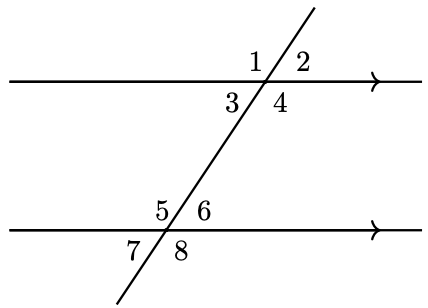1.1: Angles and Basic Geometry
( \newcommand{\kernel}{\mathrm{null}\,}\)
The material in this section focuses on the basic Geometry needed for the rest of this course. Angles (in degrees), circles, and areas of circles are the main focus (anything to do with triangles is reserved for the next section).
|
 Hawk A.I. Section-Specific Tutor Please note that, to access the Hawk A.I. Tutor, you will need a (free) OpenAI account. |
Angles
Before we can jump into Trigonometry, we must define angles; however, before defining angles, we need to define what makes up the components of an angle.

Note that we label the initial point P. The choice of letter is arbitrary, so we could just have easily chosen Q, R, or S. The choice of using capital letters for points on a line or ray, however, is tradition and we stick with that convention in this text. We now move on to defining an angle.
Figure 1.1.2 shows two examples of what are commonly considered as angles.

Figure 1.1.3 also depicts angles - albeit these are, in some sense, extreme cases. In the first case, the two rays are directly opposite each other, forming what is known as a straight angle; in the second, the rays are identical, so the "angle" is indistinguishable from the ray itself.

Now that we have an idea of what makes an angle, and a "beginner's notation," it's time we define the measure of an angle.
There is one immediate problem with this definition, as should be evident from Figure 1.1.4 below.

Which amount of rotation are we attempting to quantify?
We have just discovered that this diagram describes at least two angles. Clearly, these two angles have different measures because one appears to represent a larger rotation than the other, so we must label them differently.
In Trigonometry, we often use lowercase Greek letters to represent the measure of the angle. For example, we use the Greek letters α (alpha) and β (beta) as representations of the unknown angle measures in Figure 1.1.5.

Identifying the lowercase Greek letters will be beneficial in this course. Table 1.1.1 summarizes the (lowercase) Greek alphabet. The letters in bold are the ones most commonly used within Trigonometry.
Table 1.1.1: Lowercase Letters in the Greek Alphabet
Greek Alphabet α alpha β beta γ gamma δ delta ϵ epsilon ζ zeta η eta θ theta ι iota κ kappa λ lambda μ mu ν nu ξ xi o omicron π pi ρ rho σ sigma τ tau v upsilon ϕ phi χ chi ψ psi ω omega
The lowercase Greek letter π is never used as a symbolic representation of an unknown angle. π is reserved for the universal constant π≈3.141592654 (which is an irrational number).
Another ambiguity that sneaks into angular measure is which direction the angle is "opening." We need to extend our notion of "angle" from merely measuring an extent of rotation to quantities associated with real numbers. To that end, we introduce the concept of an oriented angle.
As its name suggests, in an oriented angle, the direction of the rotation is essential.

Alternative Angle Notations
We have already mentioned that we will frequently use lowercase Greek letters when referencing angles; however, this is not the only convention that exists when referencing an angle. Angles may be labeled with a single letter at the vertex as long as it is clear that there is only one such angle. For example, in Figure 1.1.7 (below), it is clear that angle A is the vertex. There is no ambiguity about this fact. Therefore, an acceptable notation to reference this angle is ∠A (some texts might use the notation m∠A, meaning "the measure of angle A").

However, if there is the possibility for confusion, angles are labeled by specifying 3 points, with the center point being the angle's vertex. Therefore, we could reference the angle in Figure 1.1.7 as ∠BAC. The first letter indicates the initial side of the angle, the middle is the vertex, and the last letter indicates the terminal side. It is crucial that the center letter in this notation is the angle's vertex.
Degree Measure
One commonly used system to measure angles is degree measure. Quantities measured in degrees are denoted by the familiar "∘" symbol.
Figure 1.1.8 shows the degree measures for a full, half, and quarter revolution. Since we define a full revolution as being 360∘, half of a revolution measures 12(360∘)=180∘, a quarter of a revolution measures 14(360∘)=90∘, and so on.

The following theorem is a direct result of Figure 8.
In Figure 1.1.8, we have used the small square "◻" to denote a very special angle - the right angle.
The right angle is a very special angle in Trigonometry. As such, we use it as a sort of "measuring stick" against which we judge other angles. One such judgement is whether the measure of an angle is smaller or larger than the measure of a right angle.
It is important to note that, theoretically, we can know the measure of any angle as long as we know the proportion it represents of the entire revolution. For instance, the measure of an angle which represents a rotation of 23 of a revolution would measure 23(360∘)=240∘, the measure of an angle which constitutes only 112 of a revolution measures 112(360∘)=30∘, and an angle which indicates no rotation at all is measured as 0∘ (see Figure 1.1.9).

We now investigate the relationship between two angles whose measures add to 90∘ or 180∘.
In the diagram below, the angles α and β are supplementary while the pair γ and θ are complementary angles.

In this text, we will restrict the definition of complementary and supplementary angles to positive angles only. That is, despite their sum being 90∘, we will not say that α=−20∘ and β=110∘ are complementary. Other textbooks allow for this silliness, but in truth there is no need to expand these definitions to include negative angles.
Finally, in practice, the distinction between the angle itself and its measure is blurred so that the sentence "α is an angle measuring 42∘" is often abbreviated as "α=42∘."
Consider Figure 1.1.11 below.

- Which angle pairs are supplementary?
- Which angle pairs are complementary?
- Which angles are obtuse?
- Which angles are acute?
- Solutions
-
- ∠AOC and ∠BOC are supplementary, ∠AOD and ∠BOD are supplementary, and ∠AOE and ∠BOE are supplementary.
- ∠DOE and ∠BOE are complementary.
- ∠AOC, ∠AOE, and ∠DOC are each obtuse angles.
- ∠BOC, ∠BOE, and ∠DOE are each acute angles.
It could be argued in Example 1.1.1d that ∠COE is acute; however, there is no valid reference for the measure of ∠COB and ∠BOE - only a visual cue. Therefore, we avoid assuming that ∠COE is acute.
- State the complement of 27∘.
- State the supplement of 27∘.
- State the complement of α.
- State the supplement of θ.
- Answer
-
- 63∘
- 153∘
- 90∘−α
- 180∘−θ
The measuring "system" we use to measure angles is formally called the Decimal Degree (DD) system.
Therefore, angles like 38∘, 23.1∘, and 123.456∘ belong to the decimal degree system. There are other angle measure systems:
- Degree-Minute-Second (DMS): While we will eventually use this angular measurement system (specifically, in some applications), it is not necessary to introduce it at this time.
- Radians: We will introduce this "better" angular measurement system later. Without this system, we could not perform Calculus.
Angles in Rotations
Now that we have some basic information about angles and have reintroduced ourselves to a measurement system for angles, it's time to introduce an application of angular measure. Specifically, we will learn to use angles to describe rotation. For example, think of the minute hand on a clock. The minute hand moves through one complete rotation every hour, or 360∘. In two hours, the minute hand rotates through 720∘.
Through how many degrees does the minute hand rotate in an hour and a half? In forty minutes?
- Solution
-
Figure 1.1.12 
Look at Figure 1.1.12. An hour and a half represents 1.5 complete rotations, or1.5(360∘)=540∘.Forty minutes is two-thirds of an hour, so the minute hand rotates through23(360∘)=240∘
The volume control on an amplifier is a dial with ten settings, as shown below. Through how many degrees would you rotate the dial to increase the volume level from 0 to 7?

- Answer
-
252∘
Geometry Necessary for Trigonometry
Trigonometry requires a decent grasp of basic Geometry. As such, let's review some pertinent topics.
For example, ∠1 and ∠3 in Figure 1.1.14 are vertical angles, as are the angles labeled ∠2 and ∠4.

Before introducing a theorem relating vertical angles, we need to define what it means for angles to be equal.
Having clarified this, we introduce a theorem that is very useful for deriving other concepts from Geometry.
A line intersecting two parallel lines forms eight angles, as shown in Figure 1.1.15.

The line cutting through the parallel lines in Figure 1.1.15 gets a special name.
Figure 1.1.15 shows that there are four pairs of vertical angles formed by a transversal - ∠1 and ∠4, ∠2 and ∠3, ∠5 and ∠8, and finally ∠6 and ∠7; however, there are other relationships that can be seen in Figure 1.1.15.
For example, ∠1 and ∠5 are corresponding angles, as are ∠4 and ∠8. This naturally leads to the following theorem.
Our final definition concerning the transversals is one of the most popular from Geometry.
In Figure 1.1.15, ∠3 and ∠6 are alternate interior angles, as are ∠4 and ∠5.
The parallelogram ABCD shown below is formed by the intersection of two sets of parallel lines. Show that the opposite angles of the parallelogram are equal.

- Solution
-
Angles 1 and 2 are equal because they are alternate interior angles, and angles 2 and 3 are equal because they are corresponding angles. Therefore, angles 1 and 3, the opposite angles of the parallelogram, are equal. A similar argument shows that angles 4, 5, and 6 are equal.
In the figure from Example 1.1.3, suppose ∠1=83∘. Find each of the following angular measures.
- ∠2
- ∠5
- ∠4
- ∠3+∠6
- Answer
-
- 83∘
- 97∘
- 97∘
- 180∘
Circles
We end this section with one of the defining geometric structures in all of Mathematics - the circle.

Figure 1.1.17 shows a circle of radius r centered at a point O. In fact, the word "radius" plays two roles in Geometry. By definition, the radius is the distance between the center of a circle and its edge; however, any line segment joining the center of a circle with any single point on the circle itself is called a radius. Therefore, the word radius simultaneously refers to a distance and a line segment.
Just like the radius, the diameter of a circle, denoted as d in Figure 1.1.17, has two interpretations. Our first is in terms of distance.
This definition naturally leads to the following theorem.
As with the radius of a circle, the second interpretation of the diameter is in terms of a line segment.
The terminology from Geometry related to circles extends beyond center, radius, and diameter (e.g., arc, chord, sector, and tangent); however, we will introduce these only as needed.
Circumference
Now that we have the basic definition of a circle, let's dive into some measurements.
In Figure 1.1.17, the circumference is denoted using the letter C.
A proof of this fundamental theorem in Mathematics is beyond the scope of this course.
In the theorem presented for the circumference, it would be more impactful to state the circumference is proportional to the diameter. That is,C= some number ×d.It turns out that the value of "some number" (which is commonly called the constant of proportionality) is the universal constant π. That is,C=πd⟹π=Cd.This fascinating fact tells us that no matter the size of the circle, the ratio of its circumference to its diameter is always this magical number that we call π.
It is common to hear someone say, "the circumference of a circle." However, the word circumference only applies to circles. Therefore, saying "the circumference of a circle" is redundant. For non-circular two-dimensional shapes, we use the word perimeter instead of circumference.
Loi buys a ring light for her YouTube videos. The light is circular and has a radius of 7 inches. What is the circumference of her ring light?
- Solution
- We are given the fact that the radius is 7 inches. Therefore, r=7 (inches). Using the formula for circumference, we find that Loi's ring light has a circumference ofC=2πr=2π(7 inches)=14π inches≈44 inches.
Find the radius of a 100-meter circular race track. Round your answer to one decimal place.
- Answer
-
r≈15.9 meters
Area of a Circle
The area of a circle is proportional to the square of its radius.
Again, the proof of this theorem is beyond the scope of this course.
Phuong is making a circular tablecloth for her grandfather's antique oak table. If she wants the tablecloth to have a diameter of at least 7 feet (the bare minimum to cover the table), but no more than 9 feet (allowing a little bit of tablecloth to hang over the edge of the table), between what two values must the area of the tablecloth be? Round your answers to the nearest tenth of a square foot.
- Solution
- To barely cover the table, Phuong needs a tablecloth with radius 3.5 feet. Therefore, the minimum area of the tablecloth should beAminimum=πr2minimum=π(3.5)2≈38.5 square feet.At most, if she wants a little bit of the tablecloth to hang over the edge, Phuong will want the radius to be 4.5 feet. This leads to an area ofAmaximum=πr2maximum=π(4.5)2≈63.6 square feet.Any amount of circular tablecloth between 38.5 and 63.6 square feet should work nicely for Phuong's project.
If Piyali has a circular tablecloth with area 35 square feet, what is the diameter of the tablecloth?
- Answer
-
6.7 feet.




